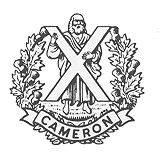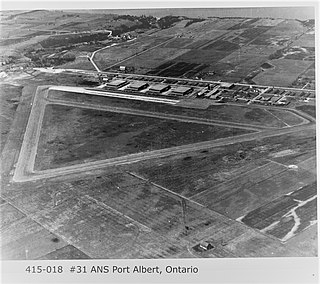
The Canadian War Museum is a national museum on the country's military history in Ottawa, Ontario, Canada. The museum serves as both an educational facility on Canadian military history, in addition to serving as a place of remembrance. The 440,000 square metres (4,700,000 sq ft) museum building is situated south of the Ottawa River in LeBreton Flats. The museum houses a number of exhibitions and memorials, in addition to a cafeteria, theatre, curatorial and conservation spaces, as well as storage space. The building also houses the Military History Research Centre, the museum's library and archives.

London International Airport is located 5 nautical miles northeast of the city of London, Ontario, Canada.

The National Museum of the United States Air Force is the official museum of the United States Air Force located at Wright-Patterson Air Force Base, 6 miles (9.7 km) northeast of Dayton, Ohio. The NMUSAF is the oldest and largest military aviation museum in the world, with more than 360 aircraft and missiles on display. The museum draws about a million visitors each year, making it one of the most frequently visited tourist attractions in Ohio.

The Royal Canadian Regiment Museum is located at Wolseley Barracks in London, Ontario, Canada.

Vanastra is a dispersed rural community and unincorporated place in the municipality of Huron East, Huron County in southwestern Ontario, Canada, 3 kilometres (1.9 mi) southeast of the community of Clinton. It is located on the former property of a top secret Royal Canadian Air Force (RCAF) station used to train and supply over 7,000 radar technicians and support staff for American, British and Canadian forces during World War II.
Canadian Forces Base Clinton, CFB Clinton for short, was a Canadian Forces Base located near Clinton, Ontario. It initially opened in July 1941 as RAF Station Clinton under the British Commonwealth Air Training Plan as a training unit for radar operators during a period when radar was a top secret device. UK, Canadian, US and other servicemen were trained at Clinton, with practical flights being carried out at nearby RCAF Station Centralia. Clinton remained the primary radar training site for Canadian Forces personnel through the Cold War era, with continued expansions throughout the 1950s and 60s. As part of a centralization effort, CFB Clinton was closed in 1971, with the site abandoned by 1972. A number of buildings remain on the site, including a large "golf ball" radome.

The Queens Own Cameron Highlanders Museum is a military museum in Winnipeg, Manitoba. The museum located at the Minto Armoury is dedicated to Manitoba's famous Scottish regiment, The Queen's Own Cameron Highlanders of Canada, which was first raised in 1910.

Canadian Forces Station Armstrong is a former General Surveillance Radar station. It is located 1.1 miles (1.8 km) east of Armstrong, Thunder Bay District, Ontario. It was closed in 1974.
The Elgin Military Museum is located in St. Thomas, Ontario. Its mandate is to preserve the local historical record of military service.

Canadian Forces Station Lowther is a closed General Surveillance Radar station. It is located 12.7 miles (20.4 km) east-southeast of Mattice-Val Côté, Ontario. It was closed in 1987.

The Comox Air Force Museum collects, preserves, interprets and exhibits artifacts relating to CFB Comox, its squadrons and its units. The museum is located at the main gate of CFB Comox, located in the Comox Valley on Vancouver Island, British Columbia. The museum opened its doors in the current location 12 September 1987. In addition to the exhibits, the museum has an aviation reference library and an aviation art gallery. The Heritage Air Park where the aircraft are on display is located 500 metres down the road from the museum as is the Y2K Spitfire restoration hangar.

The National Museum of the Mighty Eighth Air Force is a non-profit organization with a museum facility located in Pooler, Georgia, in the western suburbs of Savannah. It educates visitors through the use of exhibits, artifacts, archival materials, and stories, most of which are dedicated to the history of the Eighth Air Force of the United States Army Air Corps that served in the European Theatre during World War II.

The Commonwealth Air Training Plan Museum is an aviation museum located at Brandon Municipal Airport, Brandon, Manitoba. It is dedicated to the memory of the airmen from the British Commonwealth Air Training Plan, who trained at World War II air stations across Canada. The museum is in stage 1 of redevelopment, which will see it restored to include the main hangar, medical building, chapel, H-hut aircrew barracks, motor pool building, canteen and interpretive center.

Avenger Field is a Texas airport in Nolan County, three miles west of Sweetwater. The National Plan of Integrated Airport Systems for 2011–2015 called it a general aviation facility.

The Cold Lake Air Force Museum is a military aviation museum located in Cold Lake, Alberta. The museum preserves and exhibits the heritage and history of 4 Wing Cold Lake and 42 Radar Squadron. The Air Force Museum is actually one of four museums based on the old site of 42 Radar Squadron, who re-located to CFB Cold Lake in 1992. The Cold Lake Museums are connected to the Air Force Museum through a covered hallway affectionately dubbed 'The Tunnel'. All together, the museums are referred to as the Cold Lake Museums or the Tri-City Museums. The old facility of 42 Radar Squadron was decommissioned in 1992, and the museum opened its doors for the first time on July 1, 1998.
The Cold Lake Museums are four museums that are located on the old facility of 42 Radar Squadron on the north edge of Cold Lake South. The museums included are the Cold Lake Air Force Museum, as well as the Oil and Gas, Heritage and Aboriginal Museums. Visitors enter from into the Air Force Museum First, then pass through a covered hallway to the other three museums. The museums first opened its doors on July 1, 1998. At this time, only the Heritage and Air Force Museums were open. The Aboriginal museum first opened on June 21, 2000.

The Billy Bishop Home & Museum is a museum and National Historic Site of Canada in Owen Sound, Ontario, Canada that commemorates the life and achievements of World War I flying ace and Victoria Cross winner Air Marshall William Avery "Billy" Bishop VC, CB, DSO and Bar, MC, DFC, and to Canada's aviation history. The museum is located at his birthplace and childhood home before he went to Royal Military College of Canada in Kingston, Ontario. It features displays of artifacts including uniforms, medals, photos, models, etc. from Canadians who fought in the air during World War I and World War II, as well as a tribute to the "Red Baron" Manfred von Richthofen. The house has the original hardwood floors, Victorian furnishings and other personal possessions of the Bishop family. A gift shop is open during museum hours.
Backup Interceptor Control was the Electronic Systems Division 416M System to backup the SAGE 416L System in the United States and Canada. BUIC deployed Cold War command, control, and coordination systems to SAGE radar stations to create dispersed NORAD Control Centers.

The Texas Military Forces Museum is a history museum in Austin, Texas. It is hosted by the Texas Military Department at Camp Mabry and is part of the United States Army Historical Program.

RCAF Station Port Albert was a Second World War, Royal Canadian Air Force station located near Port Albert, Ontario, Canada in the Ashfield–Colborne–Wawanosh township. The station was home to the Royal Air Force's No. 31 Air Navigation School.
















